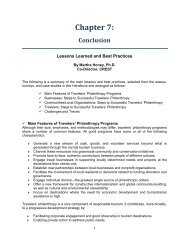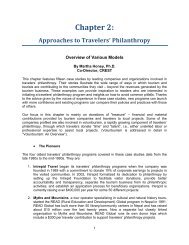Travelers' Philanthropy Handbook - Center for Responsible Travel
Travelers' Philanthropy Handbook - Center for Responsible Travel
Travelers' Philanthropy Handbook - Center for Responsible Travel
You also want an ePaper? Increase the reach of your titles
YUMPU automatically turns print PDFs into web optimized ePapers that Google loves.
• Enabling private action to address public needs.• Supporting innovation and creating possibilities <strong>for</strong> social trans<strong>for</strong>mation.• Generating social and environmental capital <strong>for</strong> conservation.• Providing resources <strong>for</strong> social development.• Mitigating the impact of state economic policy.• Offering a cost-effective means of delivering social and conservation services.The best examples of, travelers’ philanthropy are the result of careful, cooperative planning,robust finance, business acumen, accountability, and a long-term perspective. In combination,these characteristics achieve lasting results.<strong>Travel</strong>ers’ philanthropy is unique among funding sources because long-term donor support isbuilt in. The visitors (potential philanthropists) are continually brought to the destination bytourism businesses. And if donors who provide support <strong>for</strong> the local project continue to beengaged after visiting the destination, the level of philanthropy can build over time, increasingcommunity resources and making projects less likely to depend on tourism revenues alone.Tourism-based initiatives tend to allow the time necessary <strong>for</strong> complex community projects to becompleted in comparison to the deadlines set by government aid programs and foundationswhich demand swift implementation and reporting. Projects financed by travelers’ philanthropygenerally can conduct reasoned assessments of project outcomes based on project needsbecause they are organized by tourism businesses based or operating long-term in thedestination. Businesses: Steps to Successful <strong><strong>Travel</strong>ers'</strong> <strong>Philanthropy</strong>Today, all types of tourism businesses are involved in travelers’ philanthropy, from individuallodgings in a single location to international companies supporting travelers’ philanthropyprograms around the globe, to collaborative ef<strong>for</strong>ts by multiple businesses to create destinationwidetravel funds. Some travel companies have philanthropy or voluntourism as their centralmission. And those involved in travelers’ philanthropy include companies across the pricespectrum, from backpackers to high-end luxury tours that are offering a wide range of activitiesfrom eco, nature, and adventure to coastal, marine, historic, cultural, and urban tourism.Typically, these companies make corporate donations, involve at least some staff, and educateand solicit contributions from their guests <strong>for</strong> specific community and/or conservation projects.Successful travelers’ philanthropy programs are carefully designed and built on consultationswith the community and local organizations. They should include written agreements, stafftraining, communication materials, activities <strong>for</strong> visitors, and established protocols andprocedures. The tourism business develops a tourism product that incorporates selectedcommunity projects as part of the visitors’ experience -- and by doing so, creates unique andmemorable holidays.Businesses need to consider the following seven broad points when setting up a travelers’philanthropy programs:1. Carefully design and build your program based on an assessment of the areaa. Identify the geographic areas and issues you want to address through your travelers’philanthropy project.208















